A sunny day with cloud bursts and thunder displayed the good and the bad of crops around Ardee, Co Louth. For this leg of Accompany the Agronomist, the Irish Farmers Journalmet Deeside Agri Services’ agronomist, Ronan Lynch.
Ronan mainly covers crops in Co Meath, but also works around the Ardee area in Co Louth.
Working through his list of customers for the day, Ronan explained that we would probably see some of the better crops that are in the area, but commented that there are plenty of bad crops out there following wet weather since last harvest.
As the day went on, it was clear there were some excellent crops, many average to good crops and we did see poorer crops as well, which had been badly impacted by weather.
We also saw some patches in fields, which were resown after the wet winter.
Some of the later-sown winter wheat crops looked promising and while there might be less winter oats planted this year, the oats on our travels were excellent crops.

Some winter wheat did not establish well in the wet winter.
The main business, when we visited the northeast last Thursday 16 May, was aphicide and weed control on spring barley and T2 fungicides on winter wheat.
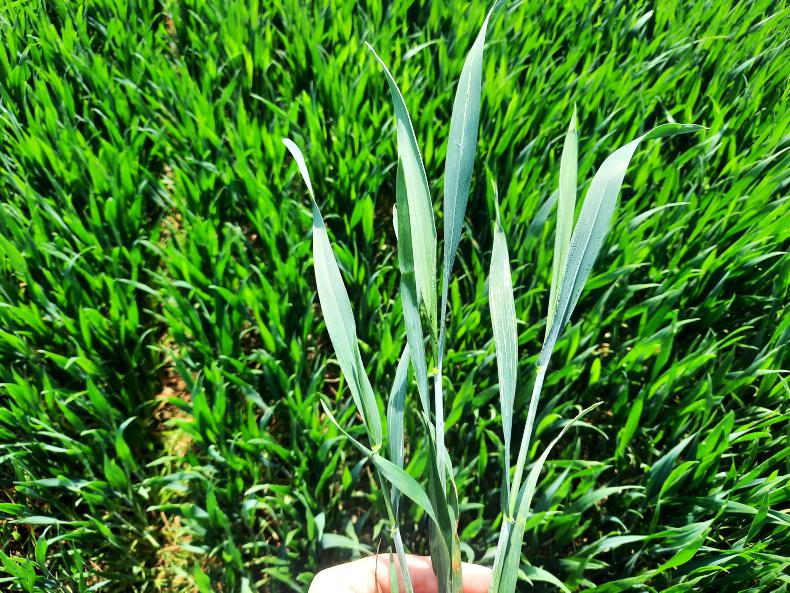
The flag leaf was emerging on winter wheat.
Spring barley was growing fast. The crops we saw were generally sown at the end of April.
Aphids could be seen from a height walking through a crop planted around 25 April.
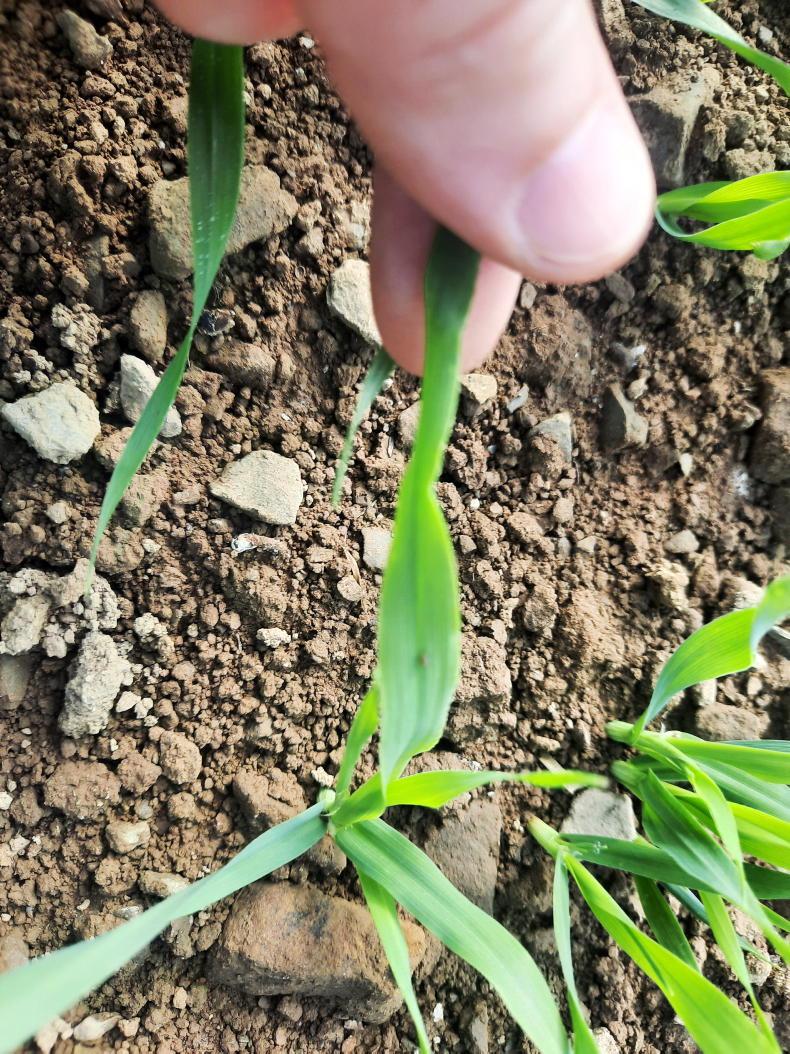
Aphids were visible on spring barley crops.
That crop was to get aphicide that day or the next, with four leaves emerging on the plant. Some small weeds were up, so a sulphonyl urea and fluroxypr would also be added.
As the plant was about to tiller CeCeCe was added, as Ronan describes, to break the apical dominance of the plant and encourage tillers.
The list on that crop was Karate at 45ml/ha, Holdup at 0.75l/ha, Savvy at 20g/ha and Starane Hi-Load at 0.4l/ha.
Avoiding a big mix in the tank, Ronan advised the farmer to return in the next week with trace elements, Nova Jett (manganese) and Nova Four – a mix made up by Deeside to cover common trace element deficiencies in its catchment.
Wild oats would also need to be managed. It was up to the farmer whether he would use Foxtrot at 0.75l/ha or Axial at 0.6l/ha.
Ronan adds recommendations to Gatekeeper and all are sent back to the office.
Dockets and recommendations are ready when the farmer comes in to collect or for a delivery and they are emailed to the farmers and the sprayer operators, if needed.
Winter wheat was all at or coming near the T2 timing and Ronan said that a lot of crops will receive their T2 by sometime next week.
Crops have very different potential, so Ronan gave farmers clear options on what different products were costing and the bigger spend was intended for the better crops.
Dawsum was looking good throughout the day.
The T2 timing is crucial to keep the flag leaf clean and it has to be said the top three leaves were very clean on most crops we saw.
Four leaves were clean on many. Septoria was the main issue at this stage.
Ronan was seeing eyespot in crops, but the timing was gone to control it. He puts some of the eyespot pressure down to less use of proline in early sprays.
All crops were receiving Folpet at 1.5l/ha and the options for the partner were Peacoq and Croton, Alonty or Ascra.
A really good crop of Dawsum received a recommendation for Peacoq at 1.6l/ha, Croton at 0.9l/ha, Lamast (Folpet) and Magnite.
Trace elements were going in, where needed, in liquid form or with Epso Combitop.

Eyespot on the inside of the stem of winter wheat.
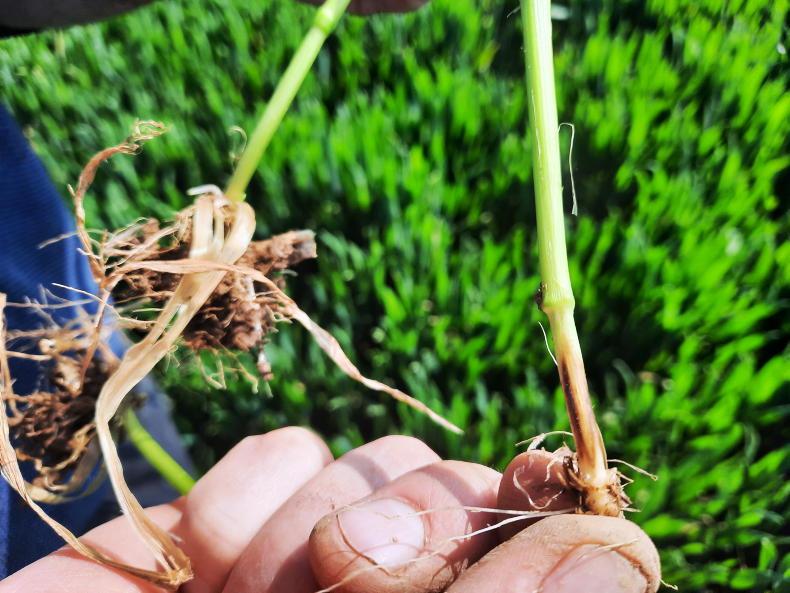
Eyespot on the outside of the stem of winter wheat.
Up to now, some T1 fungicides were delayed.
Some crops received T0s for rust and this helped towards eyespot control, as well with applications of Proline and Comet.
Ronan commented that the good wheat crops that we looked at last week were probably among the best of the crops that are out there in his area.
He noted there are plenty of worse crops and some crops were taken out and replanted.
The day we visited was warm and sunny, but with heavy downpours. Ronan was conscious that rain had fallen the previous weekend.
“There’s plenty of septoria down low in crops. There’s a lot of latent septoria in crops that we can’t see yet, but we’ll see it in two weeks,” he said.
Oats were starting to head out and crops will be due their final fungicide in the next week. This will be Elatus Era and some foliar potash. There were plenty of spring oats to see and they were at similar stages to barley around the four-leaf stage.
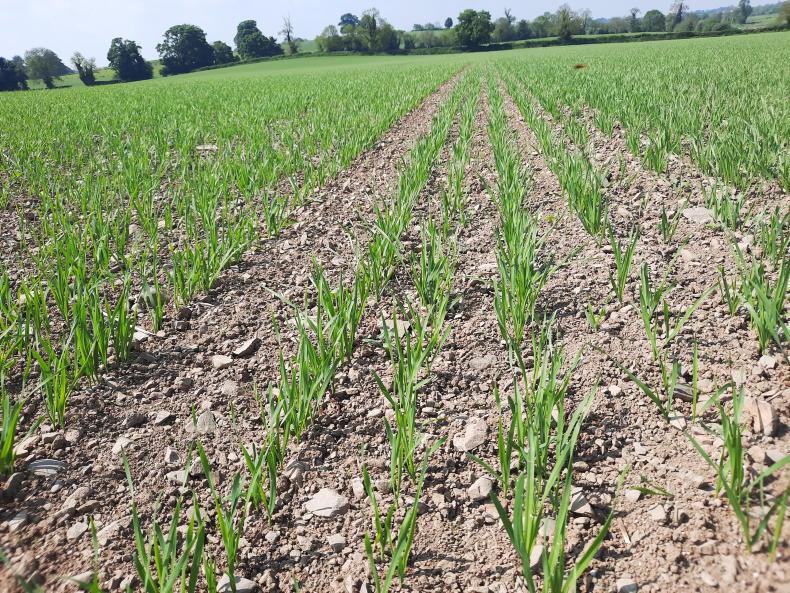
Spring oats due an aphicide and a herbicide in Co Louth.
They were advised similarly to the spring barley crop mentioned earlier with an aphicide, herbicide and growth regulator.
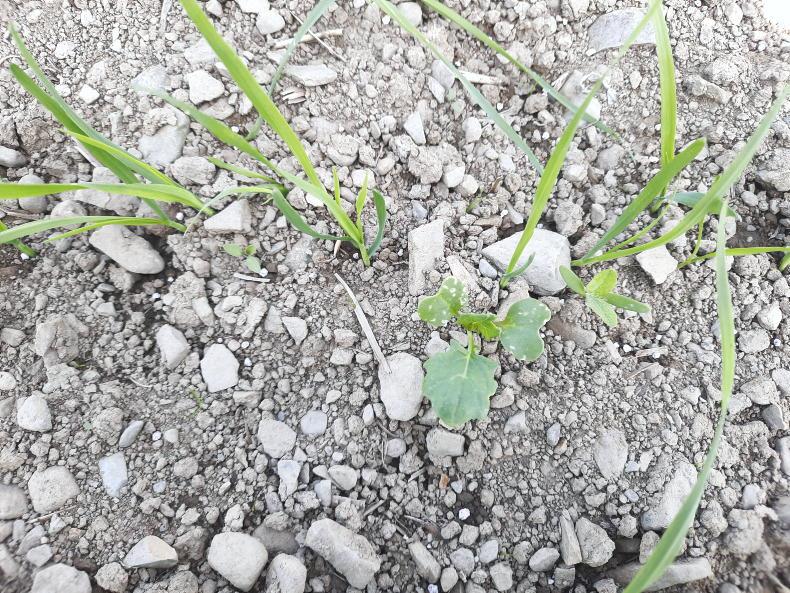
Spring oats due an aphicide and a herbicide in Co Louth.

Spring beans with wild oats and other weeds were due a herbicide.
A crop of spring beans we looked at was a picture. It emerged well and was growing fast.
However, in the middle of the busy planting season, it did not receive a pre-emergence herbicide.
There were weeds present and a lot of them were competitive such as bindweed, chickweed and fumitory. There was very little evidence of bean weevil damage.
It will receive Basagran SG at 0.8l/ha and an adjuvant, Toil, will be added at 1l/ha.
However, Ronan noted that you need sunny weather and the weeds at the right stage for this product, but it is the only real option available. Wild oats will be controlled before the bean’s flowers appear. Many were already up.
Barley yellow dwarf virus
The gate was closed on winter barley. Crops were beginning to flower last week and there was a mix of crops with plenty of barley yellow dwarf virus (BYDV) in some of them.

Some BYDV in winter wheat.
We looked at quite a bit of winter barley, as Ronan is concerned about BYDV. Some crops were badly affected, while others showed very little symptoms of the virus.
There was also virus in winter wheat. In some of these crops, it was only starting to show and would most likely look worse in a week’s time.
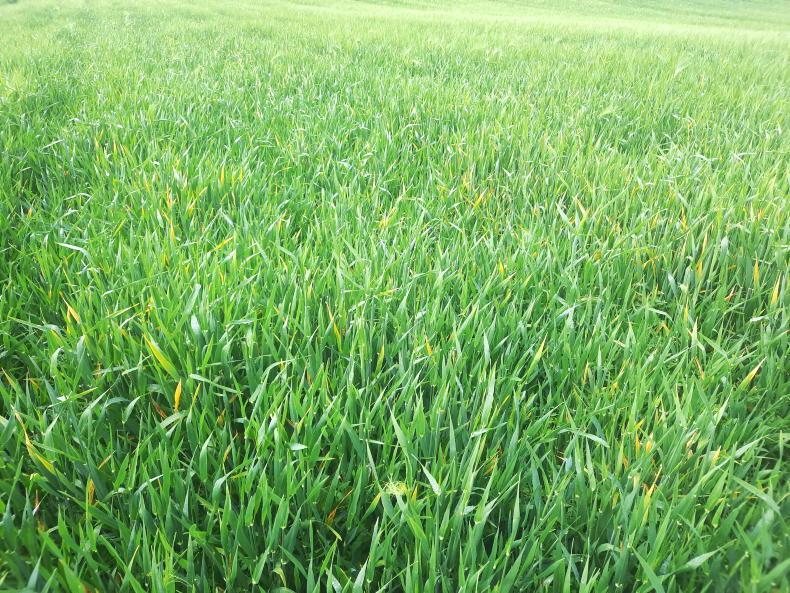
Winter barley badly stunted by virus.
Open tillage land
A field we visited in the morning was in open tillage land with very few hedges and trees nearby and certainly looked to have very little virus, while other crops were badly infected, but the reasons behind infection were all mixed.
“We’re all trying to be more conscientious about using insecticides,” Ronan commented.
He added that many of the crops we looked at were sown in the same period.
There had been dry weather from 10 to 20 October. He said the rain after planting meant that crops did not receive an insecticide.
In years where farmers cannot apply an aphicide and crops could be infected in November, Ronan wondered if there is a benefit to an aphicide in late February at mid to late tillering when, in theory, the crop should not be susceptible to further infection.
After all, with rain over the winter and frost in January, you would not think BYDV would be a big issue, as aphid pressure could be low in the bad weather.
Ronan thinks if crops could have been sprayed, there would probably be less virus, but a decision support system is needed to help farmers decide what to do and when to spray.
He doesn’t want a scenario where aphicides are being applied when they are not needed.
“Even walking fields, we saw plenty of aphids in spring crops today, but I don’t think I’ve ever seen that in winter crops as obvious or as simple a decision to make.
“If you have spring crops you know within the next three or four days you’re going to get them sprayed. Whereas if you go out in the autumn time and it could be going to rain tomorrow, you might not get back in for a week.
“It’s a lot more difficult to make the decision and then you have a much longer period where the crop is vulnerable to attack from aphids.”

Winter barley flowering in Co Louth last week.
On planting, when we visited on 16 May, Ronan said that spring cereals were nearly wrapped up, but there were some farmers with big blocks of land to sow. However, they would likely be finished that week.
Maize under plastic was estimated at 60% sown last Thursday and a shortage of plastic was causing some issues.
Beet was over 60% planted and some crops were up and receiving herbicides.
As of last Thursday, Ronan estimated that 50% or maybe a little less of potato crops were planted.
Aphids were present in spring barley.Winter wheat was all due its T2 in the coming days.The top three leaves of winter wheat were clean.Some winter barley crops suffered badly from BYDV, while others were relatively clean.
A sunny day with cloud bursts and thunder displayed the good and the bad of crops around Ardee, Co Louth. For this leg of Accompany the Agronomist, the Irish Farmers Journalmet Deeside Agri Services’ agronomist, Ronan Lynch.
Ronan mainly covers crops in Co Meath, but also works around the Ardee area in Co Louth.
Working through his list of customers for the day, Ronan explained that we would probably see some of the better crops that are in the area, but commented that there are plenty of bad crops out there following wet weather since last harvest.
As the day went on, it was clear there were some excellent crops, many average to good crops and we did see poorer crops as well, which had been badly impacted by weather.
We also saw some patches in fields, which were resown after the wet winter.
Some of the later-sown winter wheat crops looked promising and while there might be less winter oats planted this year, the oats on our travels were excellent crops.

Some winter wheat did not establish well in the wet winter.
The main business, when we visited the northeast last Thursday 16 May, was aphicide and weed control on spring barley and T2 fungicides on winter wheat.

The flag leaf was emerging on winter wheat.
Spring barley was growing fast. The crops we saw were generally sown at the end of April.
Aphids could be seen from a height walking through a crop planted around 25 April.

Aphids were visible on spring barley crops.
That crop was to get aphicide that day or the next, with four leaves emerging on the plant. Some small weeds were up, so a sulphonyl urea and fluroxypr would also be added.
As the plant was about to tiller CeCeCe was added, as Ronan describes, to break the apical dominance of the plant and encourage tillers.
The list on that crop was Karate at 45ml/ha, Holdup at 0.75l/ha, Savvy at 20g/ha and Starane Hi-Load at 0.4l/ha.
Avoiding a big mix in the tank, Ronan advised the farmer to return in the next week with trace elements, Nova Jett (manganese) and Nova Four – a mix made up by Deeside to cover common trace element deficiencies in its catchment.
Wild oats would also need to be managed. It was up to the farmer whether he would use Foxtrot at 0.75l/ha or Axial at 0.6l/ha.
Ronan adds recommendations to Gatekeeper and all are sent back to the office.
Dockets and recommendations are ready when the farmer comes in to collect or for a delivery and they are emailed to the farmers and the sprayer operators, if needed.
Winter wheat was all at or coming near the T2 timing and Ronan said that a lot of crops will receive their T2 by sometime next week.
Crops have very different potential, so Ronan gave farmers clear options on what different products were costing and the bigger spend was intended for the better crops.
Dawsum was looking good throughout the day.
The T2 timing is crucial to keep the flag leaf clean and it has to be said the top three leaves were very clean on most crops we saw.
Four leaves were clean on many. Septoria was the main issue at this stage.
Ronan was seeing eyespot in crops, but the timing was gone to control it. He puts some of the eyespot pressure down to less use of proline in early sprays.
All crops were receiving Folpet at 1.5l/ha and the options for the partner were Peacoq and Croton, Alonty or Ascra.
A really good crop of Dawsum received a recommendation for Peacoq at 1.6l/ha, Croton at 0.9l/ha, Lamast (Folpet) and Magnite.
Trace elements were going in, where needed, in liquid form or with Epso Combitop.

Eyespot on the inside of the stem of winter wheat.

Eyespot on the outside of the stem of winter wheat.
Up to now, some T1 fungicides were delayed.
Some crops received T0s for rust and this helped towards eyespot control, as well with applications of Proline and Comet.
Ronan commented that the good wheat crops that we looked at last week were probably among the best of the crops that are out there in his area.
He noted there are plenty of worse crops and some crops were taken out and replanted.
The day we visited was warm and sunny, but with heavy downpours. Ronan was conscious that rain had fallen the previous weekend.
“There’s plenty of septoria down low in crops. There’s a lot of latent septoria in crops that we can’t see yet, but we’ll see it in two weeks,” he said.
Oats were starting to head out and crops will be due their final fungicide in the next week. This will be Elatus Era and some foliar potash. There were plenty of spring oats to see and they were at similar stages to barley around the four-leaf stage.

Spring oats due an aphicide and a herbicide in Co Louth.
They were advised similarly to the spring barley crop mentioned earlier with an aphicide, herbicide and growth regulator.

Spring oats due an aphicide and a herbicide in Co Louth.

Spring beans with wild oats and other weeds were due a herbicide.
A crop of spring beans we looked at was a picture. It emerged well and was growing fast.
However, in the middle of the busy planting season, it did not receive a pre-emergence herbicide.
There were weeds present and a lot of them were competitive such as bindweed, chickweed and fumitory. There was very little evidence of bean weevil damage.
It will receive Basagran SG at 0.8l/ha and an adjuvant, Toil, will be added at 1l/ha.
However, Ronan noted that you need sunny weather and the weeds at the right stage for this product, but it is the only real option available. Wild oats will be controlled before the bean’s flowers appear. Many were already up.
Barley yellow dwarf virus
The gate was closed on winter barley. Crops were beginning to flower last week and there was a mix of crops with plenty of barley yellow dwarf virus (BYDV) in some of them.

Some BYDV in winter wheat.
We looked at quite a bit of winter barley, as Ronan is concerned about BYDV. Some crops were badly affected, while others showed very little symptoms of the virus.
There was also virus in winter wheat. In some of these crops, it was only starting to show and would most likely look worse in a week’s time.

Winter barley badly stunted by virus.
Open tillage land
A field we visited in the morning was in open tillage land with very few hedges and trees nearby and certainly looked to have very little virus, while other crops were badly infected, but the reasons behind infection were all mixed.
“We’re all trying to be more conscientious about using insecticides,” Ronan commented.
He added that many of the crops we looked at were sown in the same period.
There had been dry weather from 10 to 20 October. He said the rain after planting meant that crops did not receive an insecticide.
In years where farmers cannot apply an aphicide and crops could be infected in November, Ronan wondered if there is a benefit to an aphicide in late February at mid to late tillering when, in theory, the crop should not be susceptible to further infection.
After all, with rain over the winter and frost in January, you would not think BYDV would be a big issue, as aphid pressure could be low in the bad weather.
Ronan thinks if crops could have been sprayed, there would probably be less virus, but a decision support system is needed to help farmers decide what to do and when to spray.
He doesn’t want a scenario where aphicides are being applied when they are not needed.
“Even walking fields, we saw plenty of aphids in spring crops today, but I don’t think I’ve ever seen that in winter crops as obvious or as simple a decision to make.
“If you have spring crops you know within the next three or four days you’re going to get them sprayed. Whereas if you go out in the autumn time and it could be going to rain tomorrow, you might not get back in for a week.
“It’s a lot more difficult to make the decision and then you have a much longer period where the crop is vulnerable to attack from aphids.”

Winter barley flowering in Co Louth last week.
On planting, when we visited on 16 May, Ronan said that spring cereals were nearly wrapped up, but there were some farmers with big blocks of land to sow. However, they would likely be finished that week.
Maize under plastic was estimated at 60% sown last Thursday and a shortage of plastic was causing some issues.
Beet was over 60% planted and some crops were up and receiving herbicides.
As of last Thursday, Ronan estimated that 50% or maybe a little less of potato crops were planted.
Aphids were present in spring barley.Winter wheat was all due its T2 in the coming days.The top three leaves of winter wheat were clean.Some winter barley crops suffered badly from BYDV, while others were relatively clean. 


















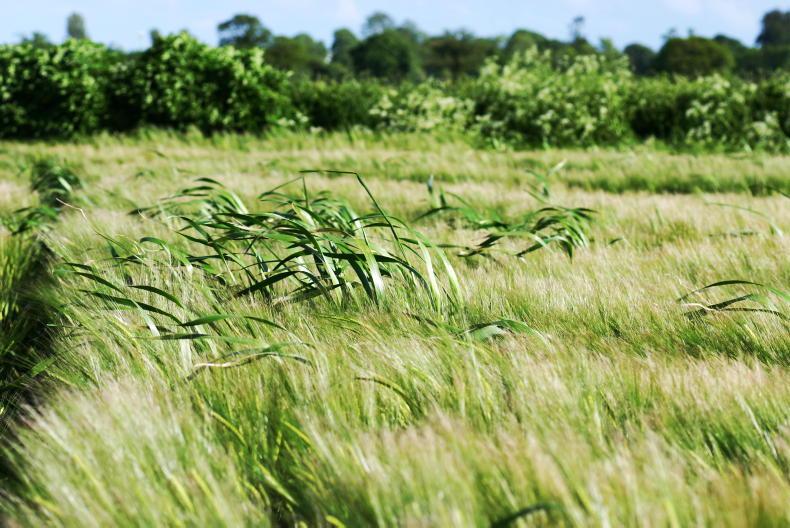

SHARING OPTIONS